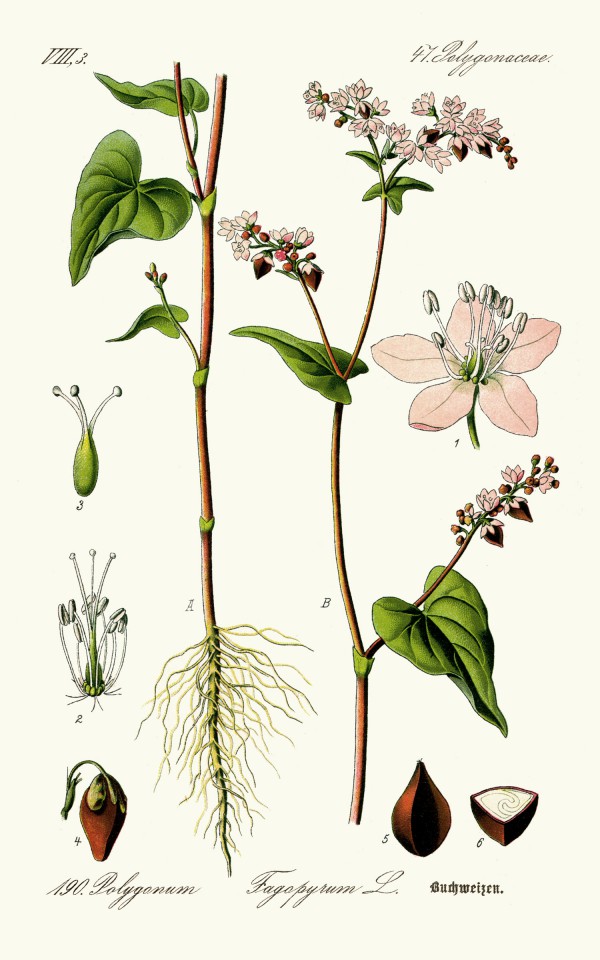Dies ist eine alte Version des Dokuments!
Fagopyrum esculentum Moench - Polygonaceae - syn.Fagopyrum sagittatum Gilibert; buckwheat, Echter Buchweizen
Cultivated in Central Asia, Europe, and America for its grain-like seeds, and also used as a cover crop.
http://en.wikipedia.org/wiki/Buckwheat
„…the newly discovered subspecies F. esculentum ssp. ancestralis Ohnishi is the wild ancestor of cultivated common buckwheat, while previously known wild tatary buckwheat, F. tataricum ssp. potanini Batalin is the wild ancestor of tatary buckwheat. Their original birthplace is revealed to be northwestern corner of Yunnan province for common buckwheat judging from the distribution of wild ancestor, and to be the northwest part of Sichuan province for tatary buckwheat judging from allozyme variability in wild tatary buckwheat. F. cymosum is not the ancestor of cultivated buckwheat; it is only distantly related to cultivated buckwheat, in morphology, isozymes and cpDNA.“
[Search for the wild ancestor of buckwheat III. The wild ancestor of cultivated common buckwheat, and of tatary buckwheat, Ohmi Ohnishi, Economic Botany,Vol.52 (2), 1998, 123-133]
Seeds contain considerable amounts of rutin, hydroxycinnamic acid, flavanols and flavone.
[Breeding Buckwheat (Fagopyrum esculentum Moench) for Flavonoids, Carolin Ölschläger, Dieter Treutter, Friedrich J. Zeller. Advances in Buckwheat Research (2004), 674] http://citeseerx.ist.psu.edu/viewdoc/download?doi=10.1.1.517.6325&rep=rep1&type=pdf
Extracts of the dried herb (Herba Fagopyri, rutin 150mg daily correponding) are regarded as capillary protective to stabilizing blood vessels (vasoprotection). [Phytotherapie bei chronisch venöser Insuffizienz, U. Kastner, B. Kopp, Dept.f.Pharmakognosie Univ.Wien] http://www.univie.ac.at/pharmakognosie/files/protected/Kastner/Teil_4%20.1_Venenleiden.pdf
„Salicylaldehyde (2-hydroxybenzaldehyde) was identified as a characteristic component of buckwheat groats aroma by a sensory analysis guided fractionation of the extract. The extract with the strongest odour was prepared by petroleum ether extraction of water soaked groats. This extract was further extracted with sodium hydrogen carbonate solution and purified by a preparative layer chromatography and identified by NMR, MS and IR spectroscopy. A capillary electrophoresis method was developed and used to determine salicylaldehyde content in buckwheat groats and flour samples. Traditionally dehulled buckwheat grain, which had the strongest odour, contained the highest concentration (1.6 ppm) of salicylaldehyde with an odour activity value (OAV) of 216.“
[Salicylaldehyde is a characteristic aroma component of buckwheat groats, Damjan Janeš, Samo Kreft, Food Chemistry, Vol.109 (2), 2008, 293-298]
Calculation of odour activity values (OAV) of volatiles quantified from freshly ground buckwheat flour showed that compounds with the highest contribution to the buckwheat aroma were: 2,5-dimethyl-4-hydroxy-3(2H)-furanone, (E,E)-2,4-decadienal, phenylacetaldehyde, 2-methoxy-4-vinylphenol, (E)-2-nonenal, decanal, hexanal and salicylaldehyde.
[Identification of buckwheat (Fagopyrum esculentum Moench) aroma compounds with GC-MS., Janeš, D., Kantar, D., Kreft, S., Prosen, H., Food Chemistry, 112(1), 2009, 120-124]
„An important consideration should be the distinction between the aroma of raw buckwheat, obained by solvent extraction and headspace techniques, and aroma of 'cooked' buckwheat obtained by SDE. Presence of certain compunds in the latter, e.g. C6-C9 aldehydes and ketones,could be seen as an artifact formation during heating although, in the particular cas of buckwheat, similar to cereals, the aroma of the cooked foodstuff is probably more important then the raw flavour.“
[Comparison of isolation methods for the determination of buckwheat volatile compounds., Prosen, H., Kokalj, M., Janeš, D., Kreft, S., Food chemistry, 121(1), 2010, 298-306]
„Tartary buckwheat tea, which is an important and healthy product, has a distinct malty aroma… The compounds with a high probability of contribution to the tartary buckwheat tea aroma (OAV≥10) were as follows: 2,5-dimethyl-4-hydroxy-3(2H)-furanone, nonanal, 2,3-diethyl-5-methylpyrazine, benzeneacetaldehyde,
maltol, 2,5-dimethylpyrazine, 2-ethyl-5-methylpyrazine, trimethylpyrazine.“
[Qin, P., Ma, T., Wu, L., Shan, F., & Ren, G. (2011). Identification of Tartary Buckwheat Tea Aroma Compounds with Gas Chromatography‐Mass Spectrometry. Journal of food science, 76(6), S401-S407]

Fagopyrum esculentum as Polygonum fagopyrum
Thomé, O.W., Flora von Deutschland Österreich und der Schweiz, Tafeln, vol.2 t.190 (1885)
http://plantgenera.org/species.php?id_species=430162&SID=0&size=1
